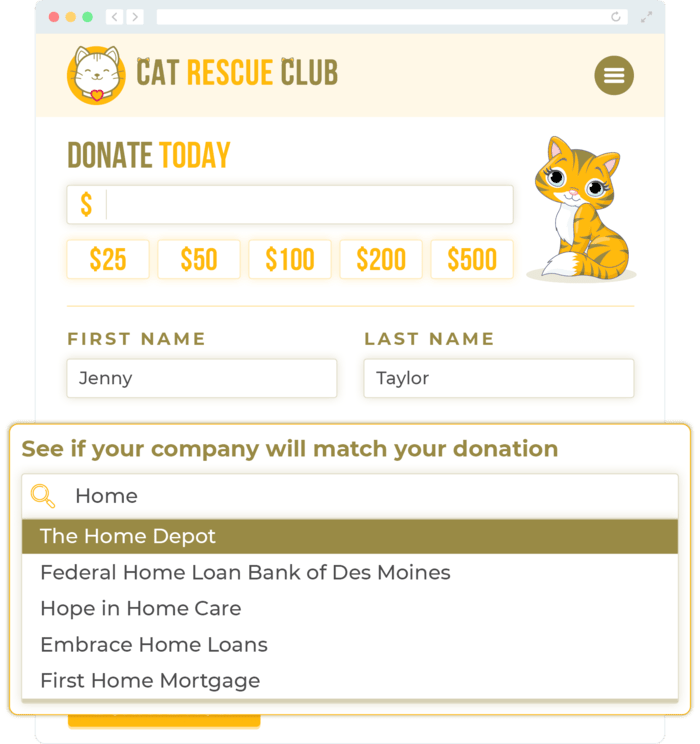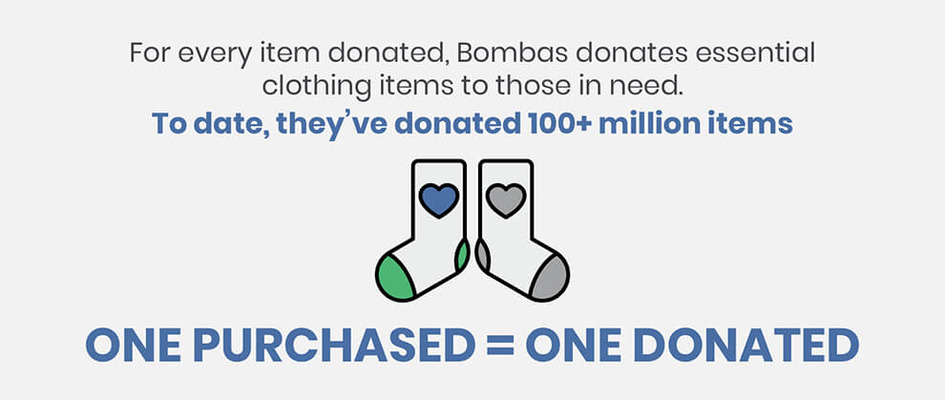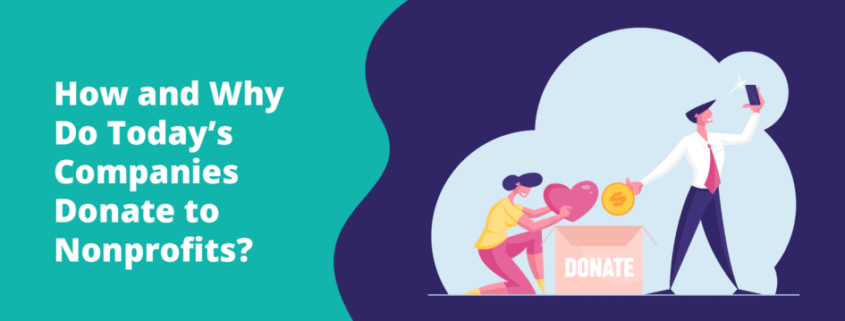How and Why Do Today’s Companies Donate to Nonprofits?
Companies gave $29.48 billion to nonprofits last year, representing an incredible 3.4% increase. Nonprofits Source shared these impressive numbers in its corporate giving trends article, indicating that companies proactively seek causes like yours to support.
The benefits of corporate support for nonprofits are clear: more revenue, extra volunteer power, and greater brand exposure. But what’s in it for the businesses? It turns out quite a bit!
It’s about more than just looking good or getting a tax write-off. A lot is happening behind the scenes, and we’re excited to share a peek. First, we’ll explore common ways companies give back before diving into the corporate motivations behind these programs. That way, you can find the best opportunities for your cause and confidently interact with companies.
5 Ways Companies Donate to Nonprofits
From employee giving programs to direct donations, corporate giving looks different at every business, yet some programs are more popular than others. Let’s start with the most impactful one.
1. Matching Gifts
Corporate matching gifts help companies give back year-round. When a business offers this program, it promises to match employees’ donations to eligible nonprofits. The approach is straightforward:
- A donor gives to your nonprofit.
- The individual researches their employer’s program using a company search tool.
- If eligible, they submit a matching gift request via paper form or their company’s employee giving portal.
- After confirming the gift, the company donates to your nonprofit.
These programs empower your nonprofit to boost donations. When someone is on the fence, being match-eligible may be the push they need to give. In fact, 84% of donors are more likely to donate if they know their gift is match-eligible. In some cases, donors will actually give more — 1 in every 3 donors to be exact.
Knowing a match is on the line even gamifies the giving experience, especially when an employer sets an annual donation goal. There’s just one problem: a lack of awareness.
You need to educate donors about these programs. Our favorite option is to embed a search tool into your donation page:

This catches donors’ attention during the height of their engagement. Using the matching gift database, they can research their companies’ guidelines. Matching gift automation software can also follow up with donors based on eligibility. While a match-eligible donor may receive an email linking to their employer’s match-request form, a donor with unknown match eligibility may be prompted to research their eligibility.
Go further than that by featuring matching gifts on your Ways to Give page, a dedicated matching gifts page, fundraising appeals, and social media. Share testimonials from beneficiaries about how an increased donation helped them, and ask your corporate partners to promote the opportunity to employees.
2. Volunteer Grants
Corporate volunteers already lend a helping hand, but did you know some employers will donate to further volunteers’ impact?
Volunteer grants are financial donations companies make to nonprofits where their employees volunteer regularly. This monetizes the volunteer hours their workforce contributes. For example, a company might donate $25 per volunteer hour, with a minimum of 5 hours required.
This encourages employees to engage in community service, knowing additional financial backing will amplify their efforts. Your matching gift database may even house information on companies’ volunteer grant programs, helping you pinpoint these opportunities.
3. Direct Donations
Other common ways companies give back are direct donations, grants, and sponsorships. For instance, AP News reports that Yield Giving, billionaire philanthropist MacKenzie Scott’s foundation, announced it would give $640 million to 361 small nonprofits that responded to an open call for applications. The open call asked for community-led nonprofits with missions “to advance the voices and opportunities of individuals and families of meager or modest means.” Eligibility was limited to nonprofits with annual budgets between $1-$5 million.
According to Renee Karibi-Whyte, the senior vice president of Rockefeller Philanthropy Advisors, open grant opportunities empower organizations without connections to specific funders. These opportunities surface organizations that wouldn’t otherwise have access to those offering major funding. Her company advises funders who run competitive grants and philanthropic prize competitions.
Companies often offer grants through their foundations. For example, 360MatchPro’s list of corporate philanthropy examples shares that the Coca-Cola Foundation awarded $94.8 million in grants to over 300 organizations in 2022.
4. In-Kind Gifts
Companies give in-kind donations of goods or services, enabling them to leverage their unique assets to support charity. Here are common examples of in-kind donations:
- Pro bono services like designing nonprofit websites or offering legal advice
- Products, such as how Chobani donates its food products to food banks, schools, and other organizations
- Free equipment or technology, such as how Google offers Workspace to nonprofits and free advertising credits via the Google Ad Grant program
In-kind gifts can directly fulfill your nonprofit’s specific operational needs or project requirements, reducing expenses and allowing you to allocate your budget directly toward your programs.
5. Cause Marketing
When a company donates a percentage of its sales, it’s known as cause marketing. This approach supports and advertises your nonprofit while also increasing consumer loyalty by aligning the company’s products and services with social causes.
For example, Bombas is a popular retailer. For every item a customer buys, the company donates a pair of socks, a t-shirt, or underwear to a shelter, transitional living facility, or other relevant organization. Through its network of over 3,500 Giving Partners, Bombas has donated over 100 million items.

4 Reasons Companies Donate to Nonprofits
If you’re a corporate partnerships manager at your nonprofit, understanding how companies give back is important, but you also need to understand why businesses engage in philanthropy. Then, you can align your communication strategy with each company’s goals and interests to secure financial support.
1. Communicate their values
Donating to nonprofits demonstrates a company’s commitment to specific social, environmental, or ethical issues, reinforcing its core values to consumers, employees, and stakeholders.
It’s about strengthening brand reputation, aligning the company’s image with stakeholders’ values, and using resources to influence the causes it supports.
To do this, companies often donate to causes aligned with their products and services. For example, The John Deere Foundation recently announced a three-year $3.9 million grant to the National FFA Organization. For context, John Deere manufactures agricultural machinery, lawn care equipment, and similar products. The unrestricted grant will enable the FFA to provide resources and educational programs to students interested in agricultural career pathways.
“This support truly helps us work toward our mission of preparing members for premier leadership, personal growth, and career success,” said FFA President Molly Ball.
As you can imagine, that grant will go a long way in supporting one of John Deere’s core values: a love for agriculture. Consider how your mission aligns with different companies’ values.
2. Boost employee satisfaction
Employees seek companies that give back to charity. Our employee giving research found that 86% of employees want to participate in corporate giving. CSR programs are linked to increased employee engagement, improved productivity, and reduced turnover by up to 50%.
Corporate philanthropy gives employees a sense of purpose beyond daily business operations. In particular, workplace giving involves employees in philanthropy.
Matching gifts make employees actively involved in corporate philanthropy. Meanwhile, volunteer grants turn employees’ hands-on involvement into financial support that amplifies their impact. Then, in-kind gifts allow employees to leverage their professional skills or contribute goods to nonprofits.
Knowing this, your nonprofit can target corporate employees to direct their workplace giving contributions to your cause. You can also communicate this benefit to corporate partners to increase their likelihood of launching these programs.
3. Tax Deductions
While companies genuinely want to give back, charitable spending is also tax-deductible. This financial incentive makes philanthropy more economically feasible for businesses and encourages them to allocate more resources toward social causes.
Use this compelling point in fundraising pitches. By highlighting donations’ altruistic and fiscal advantages, your nonprofit can strengthen its case for support and show businesses how contributing can be financially prudent.
4. Market Expansion
When a company donates to your nonprofit, it can connect with your donors, volunteers, and other corporate sponsors. That means it can introduce its brand to new markets and demographics. Plus, these new audience members will already know that the company has a philanthropic mindset, positioning the brand favorably in their eyes.
The best part is that this benefit goes both ways! Your nonprofit can access new donors and volunteers from the business’s loyal customers and employees. Corporate giving isn’t limited to industry giants either; local businesses can also boost your reach, connecting you with community members invested in making a difference.
In conversations with businesses, propose marketing their brand as a trade-off for financial support. For instance, if companies sponsor your upcoming 5K, promise to display their logos on promotional materials and event signage, offering them valuable visibility in return for their backing.
Getting Started
Companies donate in various ways for various reasons. There’s a growing commitment among businesses to contribute beyond mere profit-making, but the main point is companies are more philanthropic than ever.
Your nonprofit needs to tap into these opportunities. When navigating this evolving terrain, understanding the ‘why’ and ‘how’ of corporate giving is crucial for fostering beneficial partnerships.
Start by searching your CRM for matching gift and volunteer grant opportunities. Contact eligible supporters and explain the grant application process. When your nonprofit joins forces with philanthropic businesses like this, the potential for positive change is boundless.










